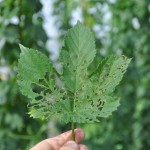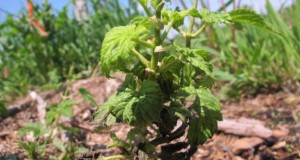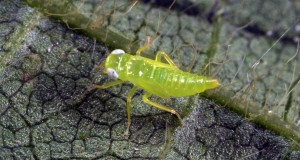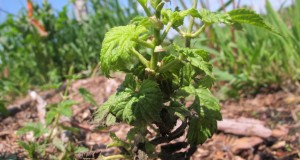Japanese Beetle Controls & Strategies
By: Great Lakes Hops
Japanese beetles are proving to be a formidable foe in hop yards located in the Great Lakes region. The beetles can cause significant damage to hop foliage and bines in a very short period of time if left uncontrolled. Two beetles can strip a large hop leaf in a single day and when their numbers reach the thousands, the beetles can strip a hop yard in just a few days. Organic hop growers find controlling them especially frustrating because they cannot apply the synthetic chemicals commonly utilized.
Here are some control strategies for all hop growers – organic and non-organic.
First concept: Beetles attract more beetles.
I do not consider Japanese beetles to be a threshold control type pest where the decision to spray is based on tolerating a certain level of pests before treatment or spraying is done. Female beetles excrete pheromones to attract males and mating is a gregarious affair – a “beetle orgy” for lack of a better term. Beetles fly into the wind and follow the pheromone trail to the plants and leaves where feeding and mating occur. Females apparently leave pheromones on the leaves; as I note that beetles arrive and continue to congregate on the same leaves – even if the original beetles are removed. However, a good hard rainfall seems to wash away this residual pheromone trail.
It is well known that hanging pheromone traps can attract large number of both male and female beetle from great distances. A population of mating beetles will grow exponentially as congregating beetles emit stronger pheromone trails for newcomers to follow to the orgy – just like a pheromone trap. Allowing the beetles to establish a population in a hop yard is exactly like hanging pheromone traps in the middle of your hop yard.
Controls & Strategies:
Knockdown Chemical control. Traditional spraying with chemicals such as Leverage, Brigade, Nuprid, & Sevin are all commonly used to kill adult beetles on hops. Organic growers have to be a bit more creative since this is not an option in their hop yards. Spraying with products like Impede, Trilogy, or SurroundWP may be options for organic growers to consider.
There are several other ways to reduce the damage caused by beetles. Using some or all of these strategies can help keep populations of the beetles under control for all hop growers.
- Intercept beetles flying in on pheromone pathways with trap plants like grapes and Rose of Sharon. There are several plants the beetles like even more than hops. The trap plants can be treated with pesticides instead of the hops. (this is still not an option for organic-certified farms). Small hop yards can often collect beetles congregating on the trap plants into buckets with a little soapy water in them. The idea is to keep the beetles from establishing a strong pheromone pathway to the hop yard.
- Make the plant unpalatable to feeding beetles. Using products like diatomaceous earth or Kalolin clay (Surround WP**) irritates the mouth parts and body joints of the beetles. Think of it as sprinkling very fine crushed glass powder into your salad and your favorite chair. If you have ever worked with fiberglass insulation, you know the sensation of itching all over!
- Disguise the hop plant. Beetles feed only on certain plants and hops happen to be one of them. What if you changed the way a hop planted smelled or tasted to the beetles? I noticed plants sprayed with phosphonic acids seem to have less feeding activity. I notice that bitter type hops like Chinook also have less feeding compared to Cascade, Centennial, or Saaz. I wonder if spraying hops with a plant extract like peppermint, cinnamon or cinnamitc acid would have the same affect? I also notice that hop leaves sprayed with kalolin look whitish and apparently have a different look to the beetles. Many of the beetles just fly on by to the next upwind plant they recognize.
- Use milky spore on hopyard soils to combat the grub phase. Realize that the mated female beetles drop to the ground under the plant where they have fed to lay their eggs. Next year the beetles don’t have to fly in – they are already in the hop yard soil with a bigger potential population than the year before! Timing is critical for application of milky spore – small grubs are easier to infect than the large mature grubs that move deeper into soil later the season. Time applications for early August in mid-Michigan. Clean row cultivation/ tilling also results in lower populations of grubs surviving.
- Treat infested areas near your hop yard, if possible. Often there are linden, basswood, river birch or other feeding sites near your hop yard you are unaware of. Take note of wind direction and days when fly-ins of Japanese beetles spikes. With a bit of detective work these sources can be identified. Sometimes treating under a neighbor’s linden trees with fall grub controls can have a big effect on the number of fly-ins to your hops. (a wee-bit neighborly, too!)
Combining all of these strategies will help control this damaging pest.
** Note: if you apply these products, a sprayer with heavy tank agitation is required – these products will settle rapidly and can clog filters, lines and seize up spray pumps.
 Photo credit: Great Lakes Hops
Photo credit: Great Lakes Hops
Pictured above: The damage a pair of beetles can do in just 24 hours.
To see the original article, click here.
 Ontario Hop Growers' Association The OHGA is a not-for-profit association of hop growers, families and enthusiasts who are interested in supporting the growth of the hop industry in Ontario.
Ontario Hop Growers' Association The OHGA is a not-for-profit association of hop growers, families and enthusiasts who are interested in supporting the growth of the hop industry in Ontario.




